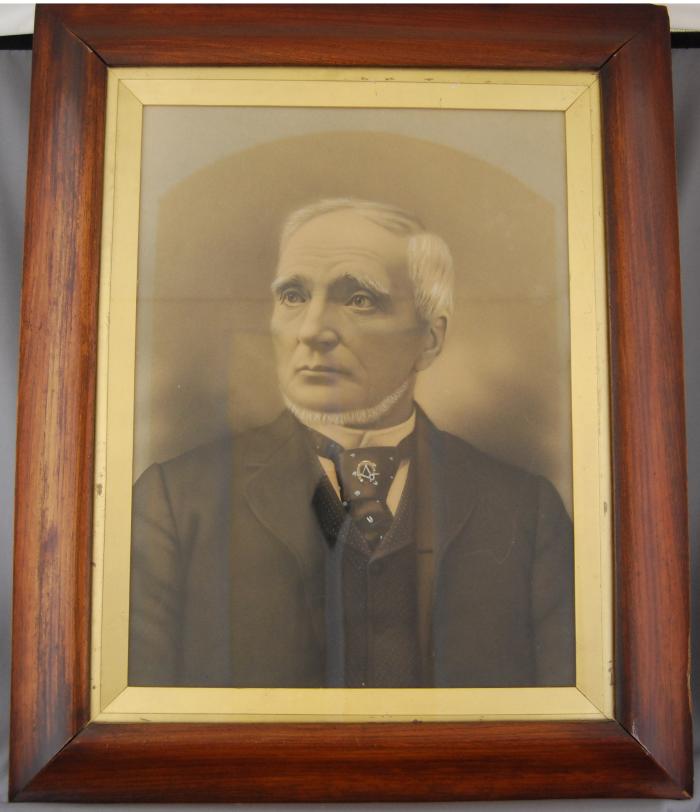Robert Dunsmuir
Biography
Robert Dunsmuir made his fortune by owning and operating coal mines in British Columbia. He was also a railway developer and a politician. He became the wealthiest person in the province. He had ten children with his wife, Joan Olive Dunsmuir.Born in Hurlford in Scotland, on August 31st 1825, Robert Dunsmuir was the first child of James and Elizabeth Dunsmuir.1 Many members of his family were coal masters and his grandfather bought and leased coal properties in Ayrshire. Amid an epidemic that swept the region in August 1832, Robert’s parents, his grandmother and two of his three sisters died.2 Robert was schooled at Kilmarnock Academy and then at Paisley Mercantile and Mechanical School where he received training to continue in the family tradition of coal master.3
On September 11th 1847, Robert married Joan Olive White, daughter of Alexander and Agnes Crooks White. Eight days later, their first daughter, Elizabeth Dunsmuir was born which resulted, for a time, in their banishment from the Kirk.4 In 1850, Robert’s uncle, Boyd Gilmour, convinced him to sign a contract, as a last minute replacement, with the Hudson’s Bay Company (HBC) to exploit coal mines on Vancouver Island.5 With less than twenty-four hours’ notice, Robert, a pregnant Joan and their two daughters set sail aboard The Pekin on December 19th.6 The voyage, which was expected to last six months, stopped at Fort Vancouver in the summer of 1851, where Joan gave birth to their first son, James. The Dunsmuirs finally reached Fort Rupert on August 9th.7
The conditions in Fort Rupert were rather bleak; the search for coal was marginally successful, there were tensions with the Indigenous population, and many miners and company workers deserted.8 As a result, the Dunsmuirs moved to Nanaimo in April 1853, where the HBC was mining coal.9
After his three-year contract expired, Robert decided to stay in Canada to continue mining as a free agent. As such, he successfully managed his own crew of miners working under contract for the HBC’s newly named Nanaimo Coal Company and later became superintendent of mining activities for the entire operation when it was renamed the Vancouver Coal Mining and Land Company.10
In 1869, northwest of Nanaimo, Robert Dunsmuir discovered a seam of coal of great quantity and quality, which became the Wellington Colliery.11 To exploit the seam, Robert was forced to take on business partners to create a company and raise capital.12 Wadham Diggle, Rear Admiral Arthur Farquhar, sons James and Alexander Dunsmuir, and son-in-law James Harvey signed on to create Dunsmuir, Diggle & Company to develop the mine, shipping operations, and to secure buyers in San Francisco and with the Royal Navy.13 Thirteen days after the crown granted rights for the company to exploit the land, James, Alex, and James Harvey relinquished their interests in the company. As Terry Reksten explains: “On 12 May 1883 Diggle signed a dissolution of partnership. He received $600,000-a tidy profit on his $8,000 investment. Dunsmuir, Diggle & Co. was renamed R. Dunsmuir & Sons, and Robert Dunsmuir became sole owner of a colliery that was producing profits of $500,000 a year.”14
With the development of the mine and rising profit, tensions arose between the miners and Robert Dunsmuir. Often perceived as personal attacks, Robert defeated every strike by using several tactics including repressing all miners’ attempts to unionize.15 The strike of 1877 is one of the major strikes that affected the company. After a market crash in the summer of 1876, Robert met his workers and explained that he could no longer pay them $1.20 per ton and keep employing all staff; the miners therefore agreed to a pay cut with the promise that the full wages would return once the market improved.16 Additional troubles emerged after it was discovered that the scales were weighing inaccurately. Therefore, in February 1877, miners went on strike and demanded a return to the pay rate of $1.20 per ton and the repair of the scales.17 The company published this response in the Nanaimo Free Press: “There is an impression in the community that we are obliged to accede to the miners demands but for the benefit of those whom it may concern we wish to state publicly that we have no intention to ask any of them to work for us again at any price. Signed Dunsmuir, Diggle & Company.”18 Strikebreakers from San Francisco were hired and Robert Dunsmuir gave miners a month’s notice to vacate the company houses.19 After more unrest, the arrival of more strikebreakers and the evictions of miners and their family by law enforcement, thirty miners went back to work in May 1877 at the rate of a dollar per ton and the rest followed suit in the following days.20
The safety and the security of the miners also became an issue in mines controlled by Robert Dunsmuir. Several explosions took miners’ lives. For example, two of the biggest mining disasters took place at Wellington on April 17th 1879 and on January 25th 1888 when a large explosion killed four Chinese men and seven white men while the other killed forty-six Chinese men and thirty-one white men.21 The use of open flame lamps was often blamed for explosions as were Chinese workers who were accused of not understanding safety warnings.22 As the anti-Chinese climate grew in British-Columbia, so did demands to exclude them from the mines.23 However, since Chinese workers were paid significantly less than whites, Robert Dunsmuir defended their employment for economic reasons, as he stated during the Royal Commission on Chinese Immigration:
They have assisted, so far, by performing labor in coal mines which others refused to perform, at wages that made such mining pay. Without them this department of the mining industry would have had a slower and less important development in this province, and the export trade of this product would have been infinitely less, because it would have been impossible but for their labor to compete in this respect in foreign markets.24
Robert Dunsmuir continued to hire Chinese men and even paid the head tax required for them to immigrate in Canada, which was to be repaid through payroll deductions.25
As his company continued to develop through competitive prices and low wages, Robert’s fortune grew. In an effort to protect his interests, he ran in provincial elections and was first elected in 1882 as a representative for Nanaimo.26 The Dunsmuir family moved to Victoria in 1883 and settled in Fairview, a residence located on the corner of Quebec and Menzies streets.27 Robert continued to invest and to expand his empire by investing in real estate, such as The Victoria Theatre, as well as accumulating shares in companies, like the Albion Iron Works and the Canadian Pacific Navigation Company.28 He also started to acquire land where he would build Craigdarroch Castle as a monument to his success.29 Additionally, in a contract signed with the federal government on August 20th 1883, Robert Dunsmuir and his partners would receive $750,000 and a grant of two million acres to build the seventy-five mile long E&N railway.30
After a severe cold that led to a coma, Robert Dunsmuir unexpectedly passed away on April 12th 1889 from what is death certificate described as uric acid poisoning.31 His funeral was estimated to have been attended by 12,000 people, which followed a procession from Fairview to St Andrew’s Presbyterian Church to Ross Bay Cemetery.32 In his will, the entirety of his possessions and empire was left to his wife Joan.33
Eliane Pineault-B.
1. Terry Reksten, The Dunsmuir Saga, (Vancouver: Douglas & McIntyre, 1991), 3. Some accounts relate the unclear origins of Robert Dunsmuir as his birth certificate is missing, see Lynne Bowen, Three Dollar Dreams, (Lantzville: Oolichan Books, 1987), 49.
2. Reksten, 4.
3. Ibid., 5.
4. Ibid., 5-6.
5. Ibid., 8.
6. Ibid., 9.
7. Ibid., 10.
8. Bowen, Three Dollar Dreams, 52.
9. Ibid., 55.
10. Ibid., 93 & 99.
11. Reksten, 23.
12. “Messr. Dunsmuir & Diggles coal claim,” 1869-1871, British Columbia Archives, Herald Street Collection, GR1069.I.200. https://search-bcarchives.royalbcmuseum.bc.ca/messr-dunsmuir-diggles-coal-claim
13. Reksten, 26-28.
14. Ibid., 54.
15. Jon Norman Griffith Bartlett, The 1877 Wellington Miners’ Strike, (BA Honors Paper, The University of Victoria, 1975), 12.
16. Ibid., 42.
17. Reksten, 37.
18. Ibid., 37.
19. Bartlett, 44.
20. Ibid., 71.
21. “The Disaster at Wellington Colliery,” Daily Colonist, 22 April 1879. https://archive.org/stream/dailycolonist18790421uvic/18790421#mode/1up/search/wellington & Bowen, Three Dollar Dreams, 178 & 277.
22. Lynne Bowen, Boss Whistle: The Coal Miners of Vancouver Island Remember, (Lantzville: Oolichan Books, 1982), 71.
23. Ibid., 70.
24. Commissioner Gray, Report of the Royal Commission on Chinese Immigration, 1885, xvii.
25. Bowen, Boss Whistle: The Coal Miners of Vancouver Island Remember, 70 & 73.
26. Reksten, 62.
27. Ibid., 70.
28. Ibid., 59 & 72.
29. RD Properties in Terry Reksten fonds, Craigdarroch Castle, Box 3, File 20.
30. Legislative Assembly of British Columbia. Contract for the Construction of the Esquimalt and Nanaimo Railway, 1883. University of British Columbia, J110.L5 S7, https://open.library.ubc.ca/collections/bcsessional/items/1.0060187#p0z-3r0f:
31. “Robert Dunsmuir Death Certificate,” 12 April 1889. British Columbia Archives, 1889-09-006922. http://search-collections.royalbcmuseum.bc.ca/Image/Genealogy/7dceafda-1816-4fe3-bba7-19dcf92aa3a9
32. Funeral To-day of the Late Hon. R. Dunsmuir, 1889. https://archive.org/details/cihm_15009/page/n5/mode/2up & Reksten, 103-104.
33. Ibid., 112.
Lifetime
1825 – 1889
Loading...



